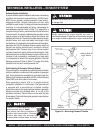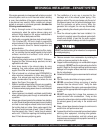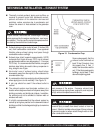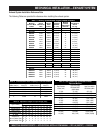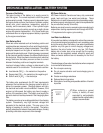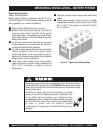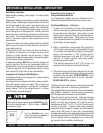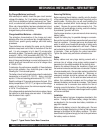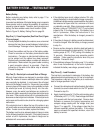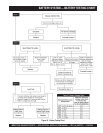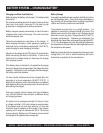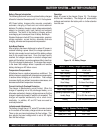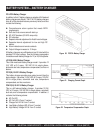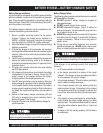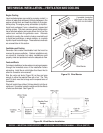
INDUSTRIAL GENERATOR SETS — APPLICATION & INSTALLATION MANUAL — REV. #4 (09/07/07) — PAGE 53
MECHANICAL INSTALLATION — NEW BATTERY
Dry Charged Batteries (continued)
After electrolyte is added, check the open circuit terminal
voltage of the battery. If a 12-volt battery reads less than 10
volts, this is an indication of either a reverse cell, an "Open"
circuit, or a shorted cell, and the battery should be replaced.
When a dry charged battery has been activated and not put
into service, it must be maintained, handled, and kept
charged like any other wet battery.
Charged and Moist Batteries — Activation
The activation characteristics of the charge and moist
batteries differ from conventional dry charged batteries in
initial fill level, specific gravity readings, and initial testing
procedures.
These batteries are activated the same as dry charged
batteries except each cell is filled to the bottom of the vent
well. It is only necessary to let it stand 10 minutes after
electrolyte is added. The specific gravity will typically fall to
a range of 1.200 to 1.230 (corrected to 80°F [26.7°C]). This
does not indicated low performance capability. After several
days of charge and discharge in normal vehicle service, the
specific gravity will rise and level out at a full charge value
of 1.245 to 1.255.
To determine the performance capability of these batteries
during initial activation, they should be given a load test
following the 10 minute soak period.
The battery should not be load tested unless the electrolyte
temperature is at least 60°F (15.5°C). Apply a test load
equal to 1/2 the
cold cranking performance
at 0°F (-17.8°C).
Read the voltage at 15 seconds and remove the load. If the
battery temperature is 70°F (21°C) or higher and the voltage
reading is 9.6 volts or more, the minimum required voltage
is 9.5 for 12-volt batteries.
If the voltage readings are below the minimum values, charge
the battery at a slow charge rate and retest. If the battery
fails the second test, reject it.
Removing Old Battery
Before removing the old battery, carefully note the location
of the positive battery terminal and mark the polarity on the
positive cable. By doing this, you will avoid installing the
new battery reversed (which could damage the electrical
system). Remove the
ground
cable connector first. This
precaution will avoid damage to wiring, and/or the battery,
by accidental "grounds" with tools.
Use the proper size box, or pen end wrench, when removing
battery cables.
Inspect the battery tray for possible damage or corrosion.
Be sure the tray and hold-down are mechanically sound and
free from corrosion. Corroded parts may be cleaned with
water (to which some household ammonia or baking soda
has been added) and scrubbed with a stiff brush. Cleaned
parts should be dried and painted. Do not paint the battery
or terminals. Clean and tighten the
ground
connection.
Tighten the starter relay and starter connections too.
Cables
Battery cables must carry large starting currents with a
minimum loss of voltage, since engine cranking speed is
dependent on the voltage available at the starting motor.
Examine the cables to ensure the insulation is intact and
the terminal connectors and bolts are not corroded. Replace
all unserviceable parts. Also consider replacing cables that
have temporary terminal ends bolted on. Temporary or
emergency terminals should be replaced with new cables
as soon as possible. As the acid corrodes terminals and
cables, their resistance increases and the voltage loss
between the battery and the starter increases. This increase
in resistance due to corrosion also restricts the flow of
charging current to the battery. This condition will eventually
cause the battery to become undercharged and the plates
will become sulfated.
Installation
Be sure the battery has been charged as described in this
section. If using an MQ Power battery, charge the battery
as described in the low water-loss battery installation on
page 56 if needed.
Make sure the battery is level in the battery rack. Be sure
there are no foreign objects lying in the tray that may cause
damage to the bottom of the battery container. The hold-
down should be tightened snugly, but not to the point where
the battery cracks or distorts.
Figure 17. Typical Electric Starter Motor Connections




